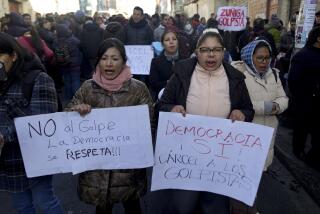Foreigners Evacuated Under Truce in Manila : Philippines: ‘Everybody goes’ in the embattled financial district. The insurrection continues.
- Share via
MANILA — Rebel commandos laying siege to Manila’s high-rise financial district since a coup attempt deteriorated into urban warfare last Saturday released thousands of foreign and Filipino businessmen, tourists and their families this morning.
Smiling with relief and waving white flags, about 300 Americans who had been trapped in luxury condominiums and five-star hotels for the past four days were escorted from the besieged district in Philippine government buses under a temporary cease-fire agreement reached late Tuesday night.
“We are evacuating all the civilians,” said Lt. Col. Rafael Galvez, field commander for the right-wing rebel forces that are demanding government reforms and the resignation of Philippine President Corazon Aquino.
“Everybody goes--including the Americans,” Galvez said in an interview inside one of the heavily fortified rebel strongholds in the Makati financial district as the evacuation took place. “We are not hostage-takers.”
Although details of the negotiations that led to the foreigners’ release remained sketchy today, a U.S. official confirmed that “tremendous pressure” was brought to bear on beleaguered Philippine President Corazon Aquino to avert a hostage crisis reminiscent of the 1979-81 U.S. Embassy siege in Iran.
In Washington, a State Department official said that “we’re urging Aquino not to take drastic action, such as strafing attacks or using artillery fire, that would hurt civilians.
“We want her to negotiate with the rebels so they’ll lay down their arms,” said the official, who spoke on condition he would not be named. “We do not want to see this ended by military action.”
The advice to the beleaguered Philippine president was in sharp contrast with the Administration’s usual policy against making deals with terrorists or kidnapers. However, State Department spokesman Richard Boucher sought to draw a sharp distinction between the sort of terrorism covered by the policy and the coup in the Philippines.
He said that the Administration did not consider the 200 Americans and 2,000 or so other foreigners to be hostages “in the normal sense of the word, as being held captive by specific individuals.”
“They are, however, unable to move because of the rebel presence in the area,” he said.
Despite the evacuation, which came after a night of intensive negotiations and rebel threats to release everyone but the Americans, the resolution solved only one phase of the Philippine crisis. The rebel leaders in Makati resolved to maintain their positions until Aquino resigns.
Senior loyalist officers this afternoon described the situation as “touch and go,” adding that negotiations between rebel and loyalist officers for a peaceful settlement were continuing, as was the cease-fire.
“Let us not term it surrender,” said Brig. Gen. Alexander Aguirre, head of the loyalist task force that had been battling the rebels. “There is a negotiation with them to return to barracks.”
A Times reporter inside the district during the evacuation said the estimated 400 rebel soldiers, all members of the Philippine army’s elite Scout Ranger commando group, appeared relaxed, resolute, well-provisioned and heavily armed with dozens of crates of ammunition.
Outside Makati’s Twin Towers condominium, which several sources said is the main rebel arsenal, troops were unloading a large crate of dynamite, C-4 plastic explosives, boxes of flares and two large reels of wire.
Asked what the rebels planned to do with the explosives, a commando on the scene said it was “to fortify our defense.”
“If Cory (Aquino) steps down,” Galvez, the rebel field commander, said, “we will leave.”
Teary-eyed, tired and unrehearsed, Aquino appeared today on government television and sharply condemned the rebel soldiers, never even mentioning that the evacuation was taking place.
“After the siege of Makati, they are now attempting the siege of the public mind,” Aquino declared in a brief, prepared statement. “We are now ready to give them the final blow and the final confrontation.”
Then, in her native Tagalog, Aquino launched into an extemporaneous and intensely personal appeal for the Filipinos to continue supporting the woman who took office four years ago during a civilian and military uprising that she proudly dubbed the “people power” revolution.
“It is very, very clear, they wanted to kill me and not be here anymore so they will reign in the country,” Aquino said, referring to the rebel aerial bombing of her presidential palace when the coup began early Friday.
“They should understand that power comes from the people. I didn’t want to be your president. I only wanted to serve you and return democracy.
“What I am asking for is your continued support.”
The devout Catholic president then appealed to all Filipinos to join in a Mass on Friday at a shrine erected on the site of the February, 1986, uprising that overthrew Philippine dictator Ferdinand E. Marcos and brought her to power.
“Don’t go because you want to give me a chance,” she said, occasionally stammering in her brief unrehearsed speech. “Go to give yourselves a chance.”
There were hints from rebel leaders at midday today that negotiations were under way to extend the cease-fire in Makati for as long as two days. But Galvez added: “There are proposals, but Mrs. Aquino must resign.
“We want to stop graft and corruption. We want to change the complexion of the political and economic elite of this country.”
Against the backdrop of the continuing siege, though, there was relief, exultation and celebration among the shaken evacuees, who, despite their ordeal, appeared unharmed.
“I feel like I’m getting out of prison,” declared Michael Buteau of Hamilton Square, New Jersey, at the government evacuation center set up near Manila’s international airport.
Describing his four days holed up inside Makati’s 10-floor Peninsula Hotel, Buteau added, “We were allowed to eat--then go back to our cells. It was awful.”
But Catherine Sebesi, a World Bank consultant from Paris who also was held inside the Peninsula, had a different view.
“It was very nice,” she said. “There was a lot of food. We were very safe.”
And the scene inside the center, which had filled with more than 100 Americans and hundreds of other evacuees from Japan, West Germany, Switzerland, Britain and other Western nations, clearly was jubilant.
Toddlers played with toys on the floor. There were many hugs among reunited families, and the government distributed sandwiches and helped the evacuees make airline or hotel reservations.
Several evacuees actually had praise for their apparent captors.
“They’ve been absolute gentlemen,” said one American who had been trapped in the Udaneta Apartment tower. “They seemed very worried about our safety.”
U.S. Ambassador Nicholas Platt, during a visit to the center this morning, praised Aquino’s government for securing the foreigners’ release, which one U.S. official said came after “tremendous pressure” was placed on the government by Washington.
Indirectly praising the rebels as well, Platt added, “there was no evidence that they (the foreigners) were being threatened or menaced and there was plenty of opportunity to threaten or menace.”
Platt confirmed that the cease-fire and evacuation came only after intensive, on-again-off-again nightlong negotiations between the rebels and the government.
The negotiation process was punctuated by a barrage of rebel propaganda. A rebel leader threatened at one point to separate the Americans from the other foreigners and continue holding them as a protest to the United States.
The threat, contained in a statement by self-styled coup leader Brig. Gen. Edgardo Abenina, who apparently was not in the Makati battle zone, also urged the Americans to plan an evacuation of all 140,000 U.S. citizens from the Philippines.
The contradiction between Abenina’s hard-line statement and Col. Galvez’s final decision to release all foreigners from the fire zone raised the possibility of a split within the rebel ranks. And the evacuation came after a daylong propaganda blitz by the rebel leaders that included several press conferences for foreign journalists and a guided visit Tuesday to the rebel-held area aboard a commandeered armored personnel.
“We’re not sure how everyone fits together here,” a U.S. official said of various Philippine officers who have claimed a leadership role in the coup, among them renegade army Lt. Col. Gregorio (Gringo) Honasan, who has been behind several previous coup attempts.
The official described as “highly professional” Lt. Col. Galvez and the other rebel officers in Makati--among them an often-decorated major who graduated from the U.S. Military Academy at West Point.
At the same time, there were signs of flexibility and even sympathy for the rebels from Aquino loyalists.
“They’re raising a lot of issues,” Lt. Col. Edilberto Adan, a government cease-fire negotiator, said during the evacuation. “We’ll see. We’re really open.”
But the evacuation came only after another day of bloodshed in the Makati district, bringing to at least 74 the number of people who have been killed since the fighting began Friday. Among Tuesday’s deaths was a 6-year-old girl who was hit by a shell fired into a squatter settlement near the Makati Medical Center.
Several hundred rebels continued to occupy Mactan Air Base in Cebu, 350 miles south of Manila, despite a midnight Monday ultimatum to surrender. A threatened government attack did not materialize.
Times staff writers Robin Wright and Norman Kempster, in Washington, contributed to this story.
More to Read
Sign up for Essential California
The most important California stories and recommendations in your inbox every morning.
You may occasionally receive promotional content from the Los Angeles Times.














